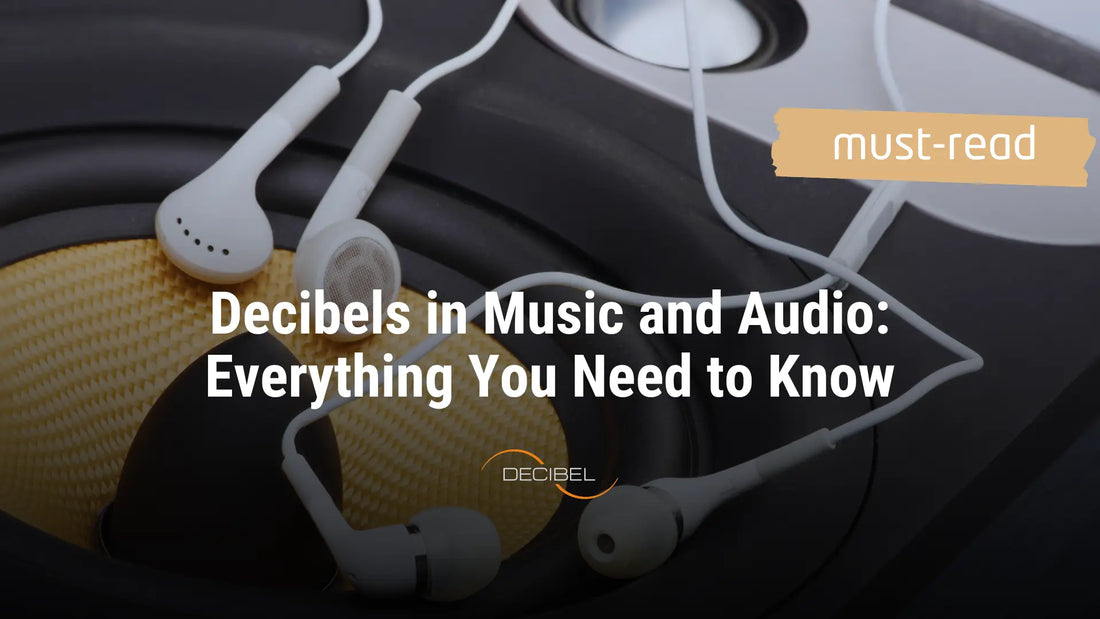
Decibels in Music and Audio: Everything You Need to Know
Tanya IlievaShare
📖 Reading time: 5 min and 48 sec
You've probably come across the term "decibels (dB)" even if you're not a sound engineer or musician. Understanding this concept is not only crucial for how we experience sound, but it can also empower you to upgrade your audio mastery. Are you ready to navigate various scenarios to enhance your acoustic knowledge?
Let us answer some burning questions and offer tips and advice to take your audio game to the next level.
The Fundamentals of dB
Decibels (dB) are used to measure how loud a sound is. It's a special way of measuring because each increase of 10 dB means the sound is 10 times more intense. This is helpful because it allows us to measure sounds that are very quiet, like a whisper, all the way up to really loud sounds, like a jet engine. For example, normal conversation is around 60 dB, while a loud rock concert can be over 120 dB. People who work with music and sound need to understand this scale so they can effectively control and manipulate sound,

The best volume for sound depends on what you are doing. For music production, most experts suggest keeping the average volume between -14 dB and -12 dB RMS. This range keeps the sound clear and detailed without causing listener fatigue, allowing producers to focus on the nuances of each track. When mixing or mastering, staying within this range ensures there is enough headroom for further processing and prevents unwanted distortion. At live concerts, sound levels usually range from 85 dB to 105 dB, creating an exciting and immersive experience for the audience. However, it's important to protect your hearing, as prolonged exposure to high volume can cause permanent damage. Using ear protection or taking breaks can help minimise risks. These guidelines help keep the sound enjoyable and safe, whether you are creating music in a studio or enjoying it at a live event.
dB in Music: How to Understand and Use Them
Understanding dB in music is all about realising how different volume levels can affect how the music sounds and how we perceive it. Lower volume levels can add a nice touch of nuance and excitement to a piece of music, while higher volume levels can make the music sound more powerful and intense. Musicians and sound experts use special tools to keep an eye on these volume levels and make sure they're just right so that we can have a great listening experience. If you’re feeling inspired to go further, a music production or audio engineering course can make a real difference. Pointblank Music School offers NASM-accredited courses that make learning feel exciting.
Here are some useful tips for managing volume levels in music:
- Use a Decibel Meter: Regularly monitor sound levels to avoid exceeding safe thresholds.
- Make Sure to Soundproof Properly: Don't forget about the peace of the others around you while keeping your audio game on top.
- Employ Compression Wisely: Compression can help manage dynamic range, preventing peaks from becoming too loud.
- Balance Instruments: Ensure all instruments and vocals are balanced within the mix to maintain clarity and prevent any single element from overpowering the rest.

Safe Listening Practices
Listening to music at safe volume levels is really important to take care of your hearing. It's recommended to keep the volume below 85 dB if you're listening for a long time. Did you know that loud sounds can impact your body? Within the first hour of being exposed to really loud noise over 90 dB, your body immediately reacts. The sensitive parts of your inner ear, like the hair cells that help you hear, get stressed out by the intense sound waves. This can cause temporary changes in how well you hear and can even increase your stress levels.

Sounds over 85 dB can harm your hearing over time. For example, personal music players at full blast can go over 100 dB. It's important to know about these noise levels and take steps to protect your hearing, like using volume limiters on your devices and taking breaks from listening to loud music.
The 3 dB Rule
The 3 dB rule is an important concept in sound and music technology. It means that when you increase the volume by 3 dB, the sound's power doubles. This rule is useful for adjusting volume levels and making sure that the sound is consistent in different places. For instance, if you turn up the volume on a speaker system by 3 dB, it will need to use twice as much power.

Common Questions About dB
Is 70 dB Music Too Loud?
Listening to music at a volume of 70 dB is generally safe and comfortable for most people, similar to the background music in a restaurant or a regular conversation. However, everyone's sensitivity to sound is different, so always listen at a level that feels comfortable for you.
What dB Should I Normalise Audio To?
When you're working with audio, normalising it usually means adjusting the volume to make sure it sounds good without being too loud or distorted. For streaming platforms, they recommend setting the loudness level to -14 LUFS (Loudness Units Relative to Full Scale) to make sure that all songs play at a similar volume. This helps make the audio sound consistent and professional.

Protecting Your Hearing
Safe dB levels for the ears are generally considered to be below 85 dB. Lengthy exposure to levels above 85 dB can lead to hearing damage. To protect your hearing, use decibel meters or smartphone apps to monitor sound levels in your environment. Here are some additional tips to protect your hearing:
- Take Regular Breaks: Give your ears a rest during long listening sessions. We know it's somehow hard when you are in the flow. However, think in the long run and don't compromise on your health in general.
- Use Ear Protection: In loud environments that you cannot control and apply soundproofing, use earplugs or noise-cancelling headphones. Did you know which is the loudest profession in the world? SPOILER ALERT: Aircraft Maintenance Engineers. They work in airport areas like maintenance hangars, runways, and taxiways. They are exposed to noise levels from 120 to 140 dB. This is like the noise of a jet engine during takeoff.
- Limit Exposure: Reduce the time you spend in noisy environments whenever possible.
- A Side Note: Studies show that using earplugs for a long time can cause discomfort, ear infections, and even hearing loss. Although they are handy, they also need replacing often and can't be shared, leading to more costs and waste. Earplugs give temporary relief. So you'd better think long term and consider proper soundproofing and acoustic treatment.

What dB Level Should a Song Be?
A well-mixed song should have an average level of -14 dB to -12 dB RMS, with peaks no higher than -1 dB. This range ensures clarity, dynamics, and a pleasant listening experience across different playback systems. Properly balanced audio not only boosts the listening experience but also preserves the integrity of the music.
We know everyone has THIS ONE SONG you can't help but put the volume on max. It's fine as long as the song is not on repeat too often.
Recognising When Music is Too Loud
Music can be too loud if it makes your ears uncomfortable, causes ringing, or makes it hard for you to hear after you're done listening. You can use a special tool called a decibel meter to check how loud the music is. If the meter shows that the sound level is higher than 85 dB, it's a good idea to lower the volume or take breaks.
The best volume for good sound quality is one that sounds clear, has all the musical details, and is comfortable for the listeners. When creating music, try to aim for an average volume level between -14 dB and -12 dB RMS. In live settings, make sure the sound is loud enough to make an impact, but not so loud that it causes distortion or hurts people's ears. It's all about balance.

Fun Facts and Additional Tips
- Did You Know? The loudest sound ever recorded was the eruption of Krakatoa in 1883, which was measured at 310 dB.
- Did You Know? Sound can shape our perception of time. Studies show that people tend to overestimate time duration when exposed to a faster rhythm and underestimate it with a slower rhythm.
- Pro Tip: Always use high-quality audio equipment and maintain it well to ensure accurate sound reproduction and avoid unnecessary increases in volume to compensate for poor sound quality.
Remember, dBs are really important in music and audio. They can affect how good the sound is and how safe it is for your ears. By knowing about and controlling the volume levels, you can make sure the sound is great and protect your hearing. It doesn't matter if you're a sound engineer, a composer, a live-stage performer, or just love sound; understanding decibels is super important to make sure everything sounds just right.
And if you need help with making your home or music studio sound better, or if you want to talk to our experts, just get in touch. Let's keep the music playing!
Additional Reading & References:
-
Rossing, T. D. (2019). The Science of Sound (4th ed.). Routledge.
-
Howard, D. M., & Angus, J. (2017). Acoustics and Psychoacoustics (5th ed.). Routledge. –
-
Everest, F. A., & Pohlmann, K. C. (2014). Master Handbook of Acoustics (6th ed.). McGraw-Hill Education.
-
U.S. Centers for Disease Control and Prevention (CDC) – Noise and Hearing Loss Prevention
-
National Institute for Occupational Safety and Health (NIOSH) – Criteria for a Recommended Standard: Occupational Noise Exposure
-
World Health Organisation (WHO) – Make Listening Safe Initiative
-
Fletcher, H., & Munson, W. A. (1933). Loudness, Its Definition, Measurement and Calculation. The Journal of the Acoustical Society of America, 5(2), 82–108.




